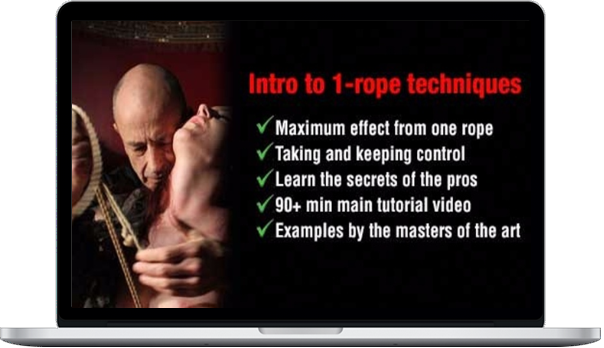Bruce Esinem – Introduction To One-Rope Techniques
$15.00 $9.00
»Delivery: Within 21 days
Description
Bruce Esinem – Introduction To One-Rope Techniques
Description Of Introduction To One-Rope Techniques
Shibari is about making every rope count
This tutorial is a perfect introduction to shibari but will also be a great help to more experienced players wanting to explore one-rope techniques. I’m sticking with ‘one-rope’ as there is endless argument over the Japanese terms. ‘Ippon nawa’ is the technically correct literal translation, although ‘ichinawa’, an incorrect translation, seems to have been coined along the way. A rose by any other name doth smell as sweet but I’ll stick with English
By using a single rope, we makes things simple but will also learn how to create the maximum effect. If you don’t already know how powerful one rope used well can be, prepare to be surprised.
We start from the beginning by discussing the tools of the job, showing how to handle them properly, explaining the basic ‘ingredients’ needed to start creating ‘rope recipes’ and sharing a lot of pro tips learned directly from masters of the art like Osada Steve and Yukimura Haruki. Of course, having preached ‘tying people, not parcels’ since before most westerners had even heard of shibari, you will benefit from a wealth of experience.
In this course, we have taken a slightly different approach by working with a student and her model. A lot of you will recognise Bliss as a prolific shibari model who has been tied by some of the best. However, this lesson is her début into tying others, although she has done some self tying. There’s no doubt that her experience as a model has taught her a lot about how experts communicate with rope. Her first attempt at a floor-work session is certainly demonstrates this. I am sure you’ll learn some tricks from her.
You will gain an insight into our own special way of teaching ingredients, rather than the more common ‘paint by numbers’ recipe-based approach. We have found that this leads to a faster grasp of the principals of building ties and a greater ability to spot one’s own mistakes, so tying more with more confidence to be creative. By developing the right habits and techniques day one, your rope will begin to have an immediate effect. Learning these skills later is much harder as you have to unlearn bad habits. It just wastes too much time and, most importantly, potential pleasure. We believe that every rope should make an impression and say something.
The video tutorials run to over 90 minutes following Bliss’s journey of learning. There’s very little edited from our class (except the likes of the blooper below), so typical beginner’s mistakes and problems are covered in great detail with my corrections and advice. If you are thinking of coming for a private class, it will give you an idea of what to expect, except I can guarantee more input from Nina when she isn’t busy being cameraman and director.
In addition, you’ll find examples of one-rope sessions, resources for further studies and explanatory notes.
About Bruce Esinem
Esinem is a shibari artist who has regularly appeared at UK and international events such as Pride, Torture Garden, Erotica, Rubber Ball, Wasteland, Boundcon, Nuit Demonia and recently represented the UK at Japan’s first international kinbaku event, Toubaku. He is also known for his teaching both in the UK and internationally and was co-organiser of the London Festival of the Art of Japanese Bondage and BOUND, Europe’s premier monthly shibari event.
Over the years, he has been improving his skills with the help some of their best known and respected Jpanese kinbakushi, Arisue Go, Osada Steve, Kinoko Hajime, Kazami Ranki and, grand master of newaza, Yukimura Haruki. Whilst drawing from classical methods, his style is distinctive and epitomizes the art of communicating with rope, often departing from the typical serenity of shibari shows and flying in the face of tradition to produce some striking and unusual performances.
In addition, he has worked on various videos, e.g. Primal Scream’s 2013, artistic collaborations and photo shoots both on and off camera. He has been involved in projects providing inspiration for Tom Ford’s 2013 collection and, Raqib Shaw, an acclaimed artist who has exhibited at the Tate, Metropolitan and White Cube galleries.
He contributed to Rope, Bondage & Power, edited by Lee Harrington and has been involved with a number of documentaries on kinbaku. He is also author of the first English language tutorial DVDs: ‘Japanese Rope Bondage: Tying people, not parcels’ .
More courses from the same author: Bruce Esinem
Delivery Policy
When will I receive my course?
You will receive a link to download your course immediately or within 1 to 21 days. It depends on the product you buy, so please read the short description of the product carefully before making a purchase.
How is my course delivered?
We share courses through Google Drive, so once your order is complete, you'll receive an invitation to view the course in your email.
To avoid any delay in delivery, please provide a Google mail and enter your email address correctly in the Checkout Page.
In case you submit a wrong email address, please contact us to resend the course to the correct email.
How do I check status of my order?
Please log in to DatingCourse account then go to Order Page. You will find all your orders includes number, date, status and total price.
If the status is Processing: Your course is being uploaded. Please be patient and wait for us to complete your order. If your order has multiple courses and one of them has not been updated with the download link, the status of the order is also Processing.
If the status is Completed: Your course is ready for immediate download. Click "VIEW" to view details and download the course.
Where can I find my course?
Once your order is complete, a link to download the course will automatically be sent to your email.
You can also get the download link by logging into your DatingCourse account then going to Downloads Page.
You may also like:
- See more 2 Girls Teach Sex courses
- See more 60 Years of Challenge courses
- See more Adam Armstrong courses
- See more Adam Gilad courses
- See more Adam Lyons courses
- See more Arash Dibazar courses
- See more Bobby Rio courses
- See more Carlos Xuma courses
- See more David Deangelo courses
- See more David Shade courses
- See more David Snyder courses
- See more David Tian courses
- See more David Wygant courses
- See more Dean Cortez courses
- See more Derek Rake courses
- See more FortWorthPlayboy courses
- See more Gabrielle Moore courses
- See more Helena Nista courses
- See more James Marshall courses
- See more Jason Capital courses
- See more Jean Marie Corda courses
- See more Joe Lampton courses
- See more Jon Sinn courses
- See more Lloyd Lester courses
- See more Love Systems courses
- See more Marisa Peer courses
- See more Matt Cook courses
- See more Matt Granger courses
- See more Nick Krauser courses
- See more Pleasure Mechanics courses
- See more Ross Jeffries courses
- See more Talmadge Harper courses
- See more The Modern Man courses
- See more Tom Torero courses
Related products
Total sold: 3
Total sold: 110










